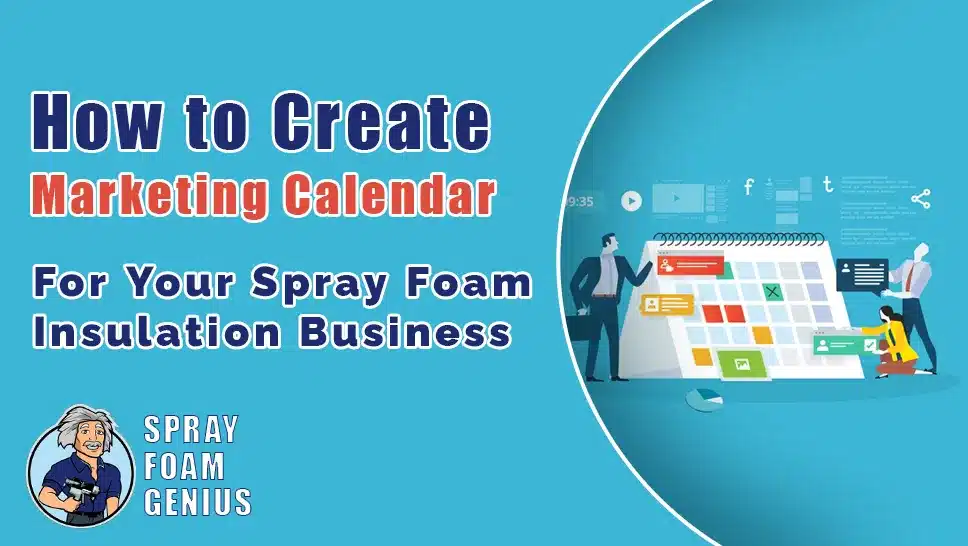
Creating a marketing calendar is crucial for any business, but it is especially important for specialized industries like spray foam insulation. A well-organized marketing calendar helps streamline your marketing efforts, ensuring that you effectively reach and engage your target audience throughout the year. This comprehensive guide will walk you through the essential steps and best practices for developing a marketing calendar tailored specifically for your spray foam insulation business.
Understanding the Importance of a Marketing Calendar
A marketing calendar is a strategic tool that provides a roadmap for your marketing activities. Here’s why it’s indispensable for your spray foam insulation business:
1. Enhances Consistency
Consistency in marketing helps build trust and brand recognition. A marketing calendar ensures that your content and outreach efforts are regular and planned, avoiding gaps in communication with your audience.
2. Improves Efficiency
By planning ahead, you can avoid the last-minute scramble of content creation and scheduling. This allows for more strategic thinking and better resource allocation, ultimately saving time and reducing stress.
3. Aligns Marketing Efforts
A marketing calendar allows you to align your marketing activities with key business milestones, industry events, and seasonal trends. This alignment ensures that your marketing efforts are timely and relevant.
4. Optimizes Resource Management
Effective budgeting and resource allocation are crucial for maximizing your marketing spend. A marketing calendar helps you plan and track expenses, ensuring that your budget is used efficiently.
Defining Your Marketing Objectives

Before you start building your marketing calendar, it’s important to define your marketing objectives. Clear objectives will guide your content creation and overall strategy. Common goals for spray foam insulation businesses include:
1. Increasing Brand Awareness
Positioning your company as a leading authority in the spray foam insulation industry is essential. Content that highlights your expertise, success stories, and the benefits of spray foam insulation can help build your brand’s reputation.
2. Generating Leads
Your marketing efforts should be designed to attract potential clients who are interested in your services. Effective lead generation strategies might include informative content, special offers, and targeted advertising campaigns.
3. Building Customer Loyalty
Engaging with your existing customers through valuable content and exclusive offers helps foster loyalty. This can lead to repeat business and referrals, which are crucial for long-term success.
4. Enhancing Online Presence
Improving your visibility online through SEO, social media, and other digital marketing tactics is essential for attracting new customers and maintaining a competitive edge.
Key Components of a Marketing Calendar
A well-rounded marketing calendar should include several critical components to ensure it covers all aspects of your marketing strategy:
1. Content Planning
Identify the types of content you will produce and distribute. For a spray foam insulation business, this might include:
- Blog Posts: Articles that cover topics such as the benefits of spray foam insulation, installation tips, and industry news.
- Social Media Updates: Posts featuring project highlights, customer testimonials, and industry insights.
- Email Campaigns: Newsletters, promotional emails, and follow-up sequences to engage with your audience.
2. Marketing Channels
Decide on the channels through which you will distribute your content. Common channels include:
- Website: Your blog, service pages, and landing pages should be central to your content strategy.
- Social Media: Platforms like Facebook, Instagram, LinkedIn, and Twitter are effective for reaching and engaging with your audience.
- Email: Regular newsletters and promotional emails can keep your audience informed and engaged.
- Local Listings: Google My Business and other local directories are important for local visibility and attracting nearby clients.
3. Key Dates and Events
Incorporate important dates and events into your calendar to ensure your marketing efforts are timely and relevant. Consider:
- Industry Conferences and Trade Shows: These events provide opportunities for networking and showcasing your expertise.
- Seasonal Trends: Adjust your marketing strategies based on seasonal changes and customer needs. For example, you might focus on energy efficiency in the winter.
- Holidays and Special Promotions: Align your campaigns with major holidays and special events to attract more attention and drive sales.
4. Content Creation and Review
Establish deadlines for content creation, review, and approval. Ensure that:
- Content is On-Brand: Maintain a consistent voice and messaging that aligns with your brand identity.
- SEO Optimization: Use relevant keywords and follow best practices for search engine visibility.
- Content is Engaging: Create content that captures your audience’s attention and encourages interaction.
5. Performance Tracking
Include metrics for tracking the success of your marketing activities. Key performance indicators (KPIs) might include:
- Website Traffic: Monitor the number of visitors and their engagement with your content.
- Lead Generation: Track the quantity and quality of leads generated through your marketing efforts.
- Engagement Rates: Measure interactions such as likes, shares, and comments to gauge audience engagement.
- Return on Investment (ROI): Evaluate the financial returns relative to your marketing expenditures.
Step-by-Step Guide to Creating Your Marketing Calendar
Step 1: Choose the Right Calendar Tool
Select a calendar tool that fits your needs and preferences. Options include:
- Digital Calendar Tools: Google Calendar, Microsoft Outlook, and Apple Calendar offer straightforward scheduling capabilities.
- Project Management Tools: Trello, Asana, and Monday.com provide more comprehensive planning and collaboration features.
- Spreadsheets: Excel or Google Sheets allow for customizable calendar layouts and easy updates.
Ensure that the tool you choose allows for collaboration and easy sharing with your team.
Step 2: Develop Your Content Strategy
Outline the types of content you will create and the frequency of updates. Your content strategy should include:
- Educational Content: Provide valuable information to your audience, such as how-to guides and industry insights.
- Promotional Content: Feature special offers, discounts, and seasonal promotions to drive sales.
- Engagement Content: Create interactive posts and share customer success stories to foster community engagement.
Step 3: Populate Your Calendar
Start filling in your calendar with scheduled content, key events, and deadlines. Make sure to:
- Incorporate Content Themes: Organize your content around specific themes or campaigns to maintain focus and coherence.
- Set Clear Deadlines: Establish deadlines for content creation, review, and publication to keep your team on track.
- Plan for Promotions: Schedule promotional content and special offers to align with your business goals and seasonal trends.
Step 4: Regularly Review and Adjust
Regularly review and update your marketing calendar to ensure it remains aligned with your business objectives and market conditions. Consider:
- Analyzing Performance Data: Use metrics to assess the success of your marketing efforts and make data-driven adjustments.
- Staying Updated with Market Trends: Keep abreast of industry trends and adjust your calendar to incorporate new opportunities.
- Gathering Feedback: Collect input from your team and audience to refine your content and strategies.
Best Practices for an Effective Marketing Calendar
1. Consistency is Crucial
Maintaining a consistent posting schedule helps build and retain your audience’s trust. Regular updates ensure that your brand remains top-of-mind.
2. Be Flexible
While having a plan is important, flexibility allows you to adapt to unexpected changes or new opportunities. Be prepared to adjust your calendar as needed.
3. Utilize Automation Tools
Marketing automation tools can streamline the scheduling and distribution of your content. Automation saves time and ensures that your content reaches your audience at optimal times.
4. Foster Engagement
Encourage interaction with your content by asking questions, hosting contests, and actively responding to comments. Engaging content helps build relationships and foster customer loyalty.
5. Monitor and Analyze Performance
Regularly track and analyze your marketing metrics to evaluate the effectiveness of your strategies. Use this data to make informed decisions and continually improve your approach.
Take the Next Step
Creating a marketing calendar tailored to your spray foam insulation business is a crucial step toward achieving your marketing goals and driving success. At Spray Foam Genius Marketing, we specialize in helping spray foam insulation contractors like you optimize their marketing strategies and achieve measurable results.
Whether you need assistance with SEO, Google My Business optimization, social media marketing, or lead generation, our expert team is here to support your business’s growth.
Contact Us Today!
Call us at 877-840-FOAM for USA and 844-741-FOAM for Canada visit our website at sprayfoamgeniusmarketing.com, or email us at [email protected] to get started.
Let’s work together to develop a marketing calendar that will elevate your business and drive impressive results.
- Social Media Marketing for Spray Foam Businesses: What Works in 2025? - February 6, 2025
- Best SEO Strategies for Spray Foam Insulation Contractors to Rank #1 on Google - February 6, 2025
- What is Spray Foam Insulation? Benefits and Applications - February 5, 2025

